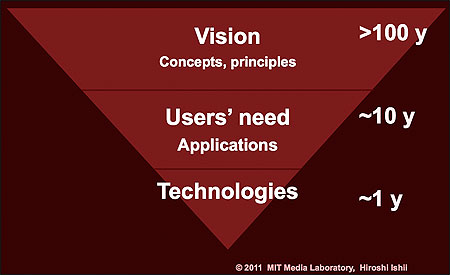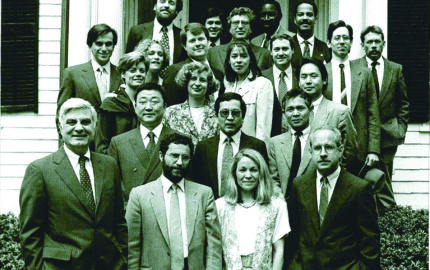Not far from the Nieman Foundation's Greek Revival house on Francis Avenue, the future dimensions of media are being explored in the modernistic glass-walled zones of the Massachusetts Institute of Technology's Media Lab. On a recent morning I visited it with Nieman Fellows, and our tour began with Hiroshi Ishii, its associate director and a Nieman affiliate (as the husband of 2012 fellow Akiko Sugaya), orienting us to what's happening there.
High-tech projects—Ping-Pong tables on which fish images swim, bottles that sing when their caps are removed—perplexed and dazzled. Still, what stuck with me is Hiroshi's PowerPoint image of an inverted triangle. Here's why: Sparse with words and numbers, it conveyed a convincing message—one I transposed from his ruminations about media to mine about journalism.

I was riveted by its clarity. While vision ripples for a century, how we apply technology has the staying power of a decade, and technology's tools come and go in a year or so. This image helped me to visualize ideas of endurance and transience, notions that until then I'd not seen so clearly. I realized then how these ideas informed the way Nieman Reports has tried to tell the stories of journalism in our digital times.
During my 13 years as editor of Nieman Reports—a job I depart with this issue—waves of digital media have washed through journalism as disruptive forces and invigorating instigators of change. Newsrooms, too slow to adapt in the minds of many, are prodded now by the pioneering efforts of entrepreneurial entities. No certain business model has been found, though lessons in sustainability are emerging even from the failures of experimentation.
As technology's tools and gadgets, apps and platforms push us to reinvent how we do our work, Nieman Reports has kept its core focus on the journalism produced, as told by those who do it best. We ask "how" and describe "why," as we wonder about "what" and think about "where." All the while we adhere to the Nieman Foundation's mission of elevating the standards of journalism.
Technologically driven inventions like those being conceived at the Media Lab carve visionary paths that, in turn, will open up new possibilities for journalists; yet technology won't determine our ethical framework or reinforce our standards, inform our judgment or strengthen our practices that set high-quality journalism apart from other sources of information. This we must do, and that belief has guided my work as the editor of Nieman Reports.
High-tech projects—Ping-Pong tables on which fish images swim, bottles that sing when their caps are removed—perplexed and dazzled. Still, what stuck with me is Hiroshi's PowerPoint image of an inverted triangle. Here's why: Sparse with words and numbers, it conveyed a convincing message—one I transposed from his ruminations about media to mine about journalism.

I was riveted by its clarity. While vision ripples for a century, how we apply technology has the staying power of a decade, and technology's tools come and go in a year or so. This image helped me to visualize ideas of endurance and transience, notions that until then I'd not seen so clearly. I realized then how these ideas informed the way Nieman Reports has tried to tell the stories of journalism in our digital times.
During my 13 years as editor of Nieman Reports—a job I depart with this issue—waves of digital media have washed through journalism as disruptive forces and invigorating instigators of change. Newsrooms, too slow to adapt in the minds of many, are prodded now by the pioneering efforts of entrepreneurial entities. No certain business model has been found, though lessons in sustainability are emerging even from the failures of experimentation.
As technology's tools and gadgets, apps and platforms push us to reinvent how we do our work, Nieman Reports has kept its core focus on the journalism produced, as told by those who do it best. We ask "how" and describe "why," as we wonder about "what" and think about "where." All the while we adhere to the Nieman Foundation's mission of elevating the standards of journalism.
Technologically driven inventions like those being conceived at the Media Lab carve visionary paths that, in turn, will open up new possibilities for journalists; yet technology won't determine our ethical framework or reinforce our standards, inform our judgment or strengthen our practices that set high-quality journalism apart from other sources of information. This we must do, and that belief has guided my work as the editor of Nieman Reports.



